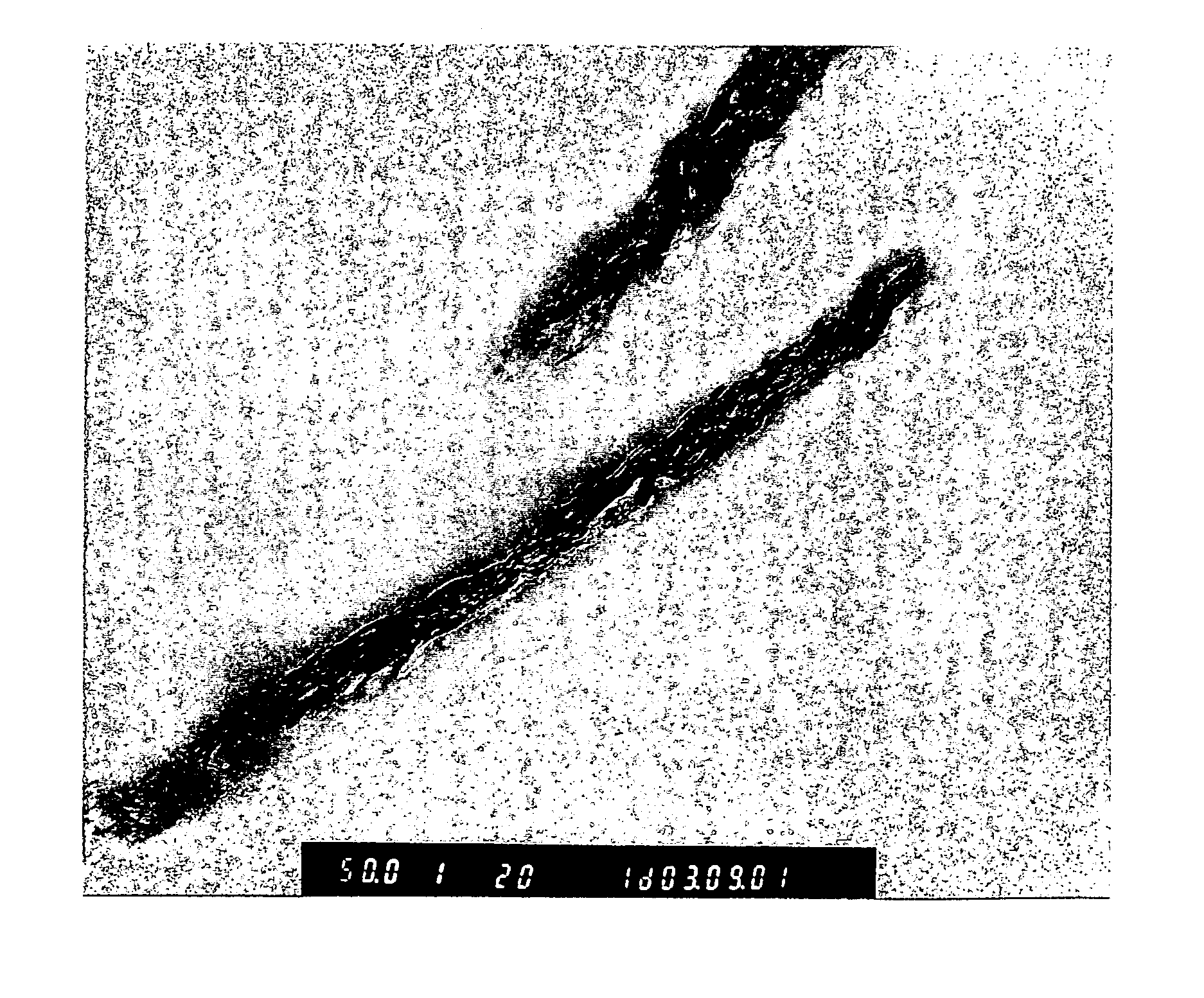Wholly aromatic polyamide fiber and process for producing the same
a technology of aromatic polyamide fiber and process, which is applied in the direction of yarn, spinning method, transportation and packaging, etc., can solve the problems of not always being able to obtain a compound material having superior strength, compound materials containing fillers are generally known to have the disadvantage of low ultimate elongation, and achieve high mechanical properties , satisfactory process stability, the effect of high toughness factor
- Summary
- Abstract
- Description
- Claims
- Application Information
AI Technical Summary
Benefits of technology
Problems solved by technology
Method used
Image
Examples
example 1
[0109] 215 g of polymetaphenylene isophthalamide having an intrinsic viscosity of 1.35 dl / g were dissolved in 785 g of NMP and stirred to a uniformly transparent dope. Separate from this procedure, a layer-structured clay mineral in the form of a smectite clay mineral treated with polyoxypropylene methyl diethyl ammonium chloride (trade name: Lucentite SPN, Co-op Chemical) was mixed and dispersed in NMP to a concentration of 1% by weight. The resulting layer-structured clay mineral dispersion was added to the wholly aromatic polyamide solution so as to have the composition shown in Table 1 followed by stirring to prepare a spinning liquid (dope). The haze of the resulting dope was 2.41. After degassing the resulting dope, it was extruded into the shape of filamentary streams from a spinneret having a cap diameter of 0.07 mm and 100 holes, the filamentary streams were introduced into a coagulation bath composed of a 43% aqueous calcium chloride solution (containing 1% by weight NMP) ...
example 2
[0110] Wholly aromatic polyamide fibers having the composition shown in Table 1 were produced in the same manner as Example 1 with the exception that smectite layer-structured clay mineral (trade name: Lucentite STN, Co-op Chemical) treated with trioctyl methyl ammonium chloride was used for the layer-structured clay mineral. The haze of the spinning liquid at this time was 1.92. In addition, the average layer thickness of the layer-structured clay mineral particles was 86 nm, and the degree of orientation A was 91%. The tensile strength, ultimate elongation and toughness factor (TF) of the resulting fibers are shown in Table 1.
example 3
[0112] 0.16 parts by weight of polymetaphenylene isophthalamide having an intrinsic viscosity of 1.9 dl / g were dissolved in 1.46 parts by weight of NMP and stirred to a uniformly transparent dope. 0.18 parts by weight of layer-structured clay mineral in the form of smectite clay mineral treated with polyoxypropylene methyl diethyl ammonium chloride (trade name: Lucentite SPN, Co-op Chemical) were added to this dope followed by stirring to prepare Polymer Solution A. Separate from this procedure, 17.44 parts by weight of polymetaphenylene isophthalamide were dissolved in 63.68 parts by weight of NMP to prepare transparent Polymer Solution B.
[0113] After mixing and stirring the Polymer Solutions A and B, 17.08 parts by weight of NMP were further added to this mixture to prepare a spinning liquid composed of 17.60 parts by weight of polymetaphenylene isophthalamide, 0.18 parts by weight of Lucentite SPN (trade name) and 82.22 parts by weight of NMP.
[0114] This spinning liquid was hea...
PUM
| Property | Measurement | Unit |
|---|---|---|
| thickness | aaaaa | aaaaa |
| temperature | aaaaa | aaaaa |
| temperature | aaaaa | aaaaa |
Abstract
Description
Claims
Application Information
 Login to View More
Login to View More - R&D
- Intellectual Property
- Life Sciences
- Materials
- Tech Scout
- Unparalleled Data Quality
- Higher Quality Content
- 60% Fewer Hallucinations
Browse by: Latest US Patents, China's latest patents, Technical Efficacy Thesaurus, Application Domain, Technology Topic, Popular Technical Reports.
© 2025 PatSnap. All rights reserved.Legal|Privacy policy|Modern Slavery Act Transparency Statement|Sitemap|About US| Contact US: help@patsnap.com



